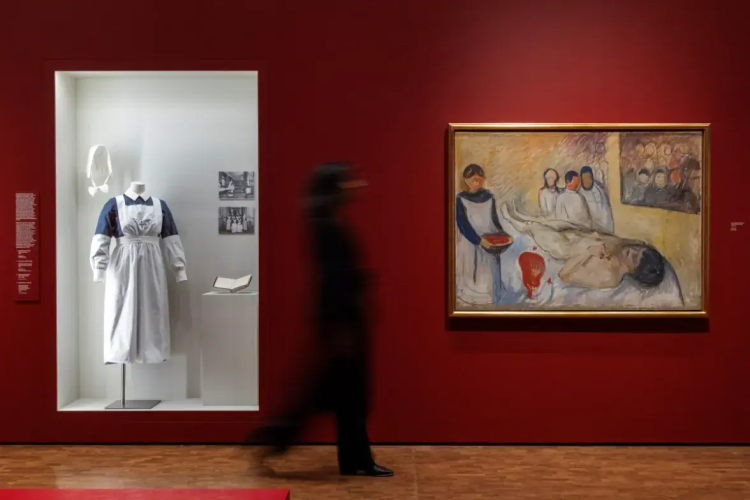Best known for his iconic painting The Scream, Norwegian artist Edvard Munch spent his career exploring the emotional and physical struggles of the human body. A new exhibition at MUNCH museum in Oslo, Lifeblood, pairs his work with historical medical objects to reflect his own experiences of illness and care, and to explore how we navigate health and sickness, birth and death, and the ways we give and receive care.

On the Operating Table is one of 150 of Munch's works that are part of Lifeblood, which runs from June 27 to September 21, 2025. (Photo by: Ove Kvavik/Munchmuseet)
Curated by Queen's University professor Allison Morehead, the exhibition draws on years of research in art history and the medical humanities. It opened on June 27, 2025, and is expected to draw more than 250,000 visitors before it closes on September 21, 2025.
Queen's research highlights gender and care in Munch's art
In 1902, during an argument with his lover, Munch sustained a likely self-inflicted gunshot wound to his left hand. He was taken to Norway's leading medical institution, where doctors X-rayed his injuries and performed surgery. The incident led him to paint On the Operating Table, which shows a naked male patient lying in a clinical setting, with three male doctors nearby, a nurse holding a bowl seemingly filled with blood, and a group of onlookers.
"Of course, Munch's surgery wouldn't have required him to be fully naked, so the painting perhaps amplifies a sense of exposure and vulnerability that likely exceeded the medical reality," says Morehead, professor in Queen's Department of Art History and Art Conservation. "The exhibit uses gender as one of its lenses for analysis, and I think this painting helps show why that matters. The patient's lack of discernable genitals, the doctors' passivity, the nurse's prominent role, all speak to how gender shapes experiences of vulnerability, identity, and the dynamics of modern medical interventions."
The painting is the first piece visitors encounter in Lifeblood. It is flanked by two glass display cases: one containing the X-ray of Munch's hand, his patient records, and surgical tools, and the other featuring items related to the history of deaconess nursing. As visitors continue through, they encounter more than 150 of Munch's works, presented alongside other medical-related objects, such as a baby incubator, glass sputum bottles, contraceptive devices, vaccine equipment, and archival photographs.
"So far, the public's reaction has been amazing, with many people moved to share stories about their own experiences of illness and health during their visit," says Morehead. "Munch's highly expressive work tends to demand an emotional response, and while the exhibition includes some difficult material, we've received a lot of appreciation for the supportive way we've presented the material."
Students contribute to art history and medical humanities research
Preparing for the exhibition was a multi-year effort for Morehead and involved the support of several Queen's master's, PhD, and medical students. Together, they contributed to secondary research, translation, material organization, image sourcing, creating online workspaces, and a variety of logistical tasks. Some joined Morehead in international workshops and worked directly with experts at MUNCH, and some have since moved into notable roles in curatorial practice and academic research. Morehead's team was supported with funding from the Social Sciences and Humanities Research Council (SSHRC) of Canada and from Queen's.
"Lifeblood is a remarkable achievement in the medical humanities that brings together Dr. Morehead's outstanding research, curatorial innovation, and public engagement," says Norman Vorano, Head of Queen's Department of Art History and Art Conservation. "What makes this project especially powerful is her integration of student collaboration at so many stages, offering meaningful, hands-on experiences that speak to her excellence as both a scholar and a teacher."
Munch exhibition fosters international collaboration
Lifeblood will play a key role in a three-day event in Oslo this September, supported by the Matariki Network of Universities (MNU) Research Seed Fund and a SSHRC Connection Grant. The event includes a two-day international workshop on medical heritage and curating, followed by a public conference on its third day.
On the second day, Morehead and Gustav Jørgen Pedersen, Head of Research at MUNCH, have organized a session in which contributors to the Lifeblood catalogue will lead discussions on the exhibition's core themes. They will be joined by interdisciplinary participants from Queen's and Matariki partner institutions Durham and Uppsala Universities, representing a wide range of academic and professional disciplines. The session aims to deepen engagement with the exhibition and to strengthen collaborative relationships in globally relevant fields of research across the MNU.
The public conference, Curating Modernism & Medicine, is organized by Morehead and Pedersen in partnership with Tanya Sheehan (Colby College) and Øystein Sjåstad (University of Oslo). In addition to the funders mentioned above, the three-day event is also supported by MUNCH, The Norwegian Museum of Science and Technology, the University of Oslo, The Savings Bank Foundation DNB, and Colby College.
For more information on Lifeblood visit the MUNCH website.










